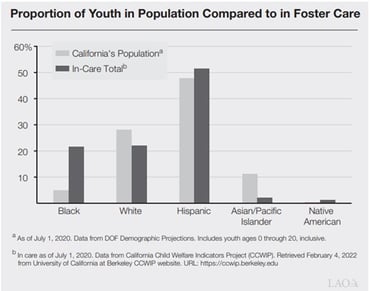 February is a time to celebrate Black History by highlighting black pioneers, the beauty of Black Culture, and take note of the progress forward in equality and civil rights. It’s also a time to reflect on our country. While we can acknowledge what we have to be thankful for, we can also look to where we can continue to improve in terms of racial and systemic issues. For us, that’s looking at how we can improve in Foster Care.
February is a time to celebrate Black History by highlighting black pioneers, the beauty of Black Culture, and take note of the progress forward in equality and civil rights. It’s also a time to reflect on our country. While we can acknowledge what we have to be thankful for, we can also look to where we can continue to improve in terms of racial and systemic issues. For us, that’s looking at how we can improve in Foster Care.
Unfortunately, foster care and child welfare systems have disproportionately affected African American children and families in comparison to the rest of the country’s population. Through education, awareness, and strategic initiatives within our services, we can improve care for current foster children and break generational and systemic cycles to correct this discrepancy.
Current Situation and Statistics
Understanding the current situation requires a bit of a dive into statistics. It is important to note that the disparity is not about the actual number of Black youth in foster care, but rather about the ratio of how many youth are represented in the foster care system versus the overall national population.
According to the Adoption and Foster Care Analysis and Reporting System (AFCARS) Report for 2022, there were over 390,000 thousand total youth in foster care across the United States. Of those youth, 22% were Black or African American, 22% were Hispanic, and 43% were White.
During the same time period, Black children made up only 14% of the population, Hispanic 26%, and White 49%. Meaning Black children have a higher representation in foster care than they do in the country as a whole which isn’t true for their peers of other races.
Foster Representation in California
In California the populations represented in foster care are 21% Black, 50% Hispanic, 22% White. Statewide Black children made up 5% of the population, Hispanic 52%, and White 24%. Once again showing Black children are overrepresented. This graph shows the overrepresentation of African American children in foster care visually.
Current Solutions and Resources
The numbers are clear that there are inequalities present and that those of us working in foster care must continue moving towards solutions that better support Black foster youth, their families, and communities.
Kinship care is one of the strategic ways we can support the cultural identity and lived experiences of its youth. Through this type of care, we are able to keep families more united and allow the youth to be with familiar faces, which helps with transitioning to a new living situation.
Kinship care has been proven to promote resiliency and better mental health as well. As a foster agency, we train and support the family members who choose to become foster caregivers to ensure they have the resources they need. It helps strengthen community and is a steppingstone to the ultimate goal of reunification between the foster child and their parents.
Kinship care also helps bridge the gap to reach populations who wouldn’t normally want to be involved in foster care.
There isn’t much statistical data on foster parents themselves. The most recent data we have tells us that in California 21% are Black, 25% White, and 50% Latino. Since the majority of foster families are White and Hispanic, what can we ask of them to support their Black foster child’s identity and lived experiences?
Dionn Schafner is a board member of Foster Village, Austin, a nonprofit that bridges the gap between foster families and caregivers and those who want to support them through practical needs and providing holistic support beyond the system. She has this advice for foster parents who want to support and celebrate their foster child’s Black culture and identity.
- Educate – Educate yourself on the child’s culture and heritage. There are many resources available from reading materials, podcasts, movies and more. Your favorite bookstore or streaming service has curated content, not just during Black History Month. Try not to put the weight of your education on the child. They are already shouldering so much between the inequities of discrimination to now the separation from their family….we don’t want to add educating someone else on their plates as well.
- Empathize – Acknowledge the child's experience and emotions; their perception is their reality. Understand the challenges they can, and most likely will face, in our society. Listen to their stories. As Seth Godin says, “Listening happens when we put in the effort to understand what the words mean….it requires a commitment to encountering the experience, intent and emotion behind the words.” There is no substitute for lived experience and if they are willing to share with you, they are offering a moment of vulnerability and trust in you.
- Engage – Actively seek out opportunities to celebrate and honor the child's heritage, not just during Black History Month, but year-round.
- Find communities of color to engage in. Representation matters, even in the resources you provide, from barbershops and salons to books with Black protagonists to clothes you provide. Basic elements, like how they can wear their hair can make a significant impact in how they view and feel about themselves and their culture.
- Help them see successful versions of themselves in the world around them. Proactively seek and point out others who share their culture and heritage being successful, overcoming trials and hardships, and navigating society. The child will need these types of resources and demonstrated resiliency to operate in a world still entangled with systemic biases and racism.
- If you can, check in with the birth family and learn whatever rituals they support as a family. Keeping this type of connection to their heritage can be enduring.
- Expect – Expect to have some hard conversations. Even when you are trying your best to educate, empathize and engage, hearing the words “You don’t know what it’s like…” can sting in their unfortunate truthfulness. Breathe. Consider the feelings at stake here, acknowledge their truth and their reality and try again, knowing you are coming from a place of good.
Read the full article here
Working on Solving the Deeper problem
The number one reason all children end up in foster care is neglect, which is closely correlated with poverty. This statistic tells us that it’s not necessarily bad parenting or people that direct children to foster care, but an inability to thrive and be healthy. Poverty is often a systemic issue and cycles generationally.
When people don’t have the resources, education, and opportunities to improve their livelihood, they can fall back into the systems they are familiar with. The African American and Black community has often been disenfranchised by this country, and the foster care youth statistics support that. This is why it’s so important that we work to correct the root of the issue.
We need to strengthen communities by working to unite families and get them the resources they need to be healthy. Reunification is always our number one goal. When we strengthen communities, we strengthen families, and bring up children in a healthy supportive environment.
What We’re Doing
Victor is dedicated to transforming lives through comprehensive mental health services, educational support, and community resources. Understanding the importance of accessibility, we provide services and information in multiple languages, with free translation services available to ensure that language is never a barrier to receiving the help you need.
Beyond individual services, Victor is deeply invested in the communities we serve. We regularly partner with programs, workshops, and schools, aiming to raise awareness and provide vital resources to those in need. Our holistic approach ensures that clients receive not only immediate assistance but also the tools they need for long-term success.
For more information about our programs and how we can help, visit our website or contact us today.

